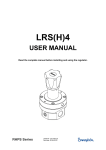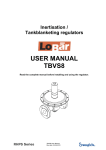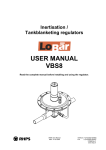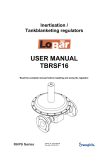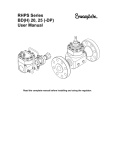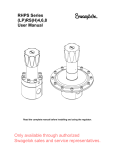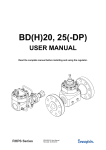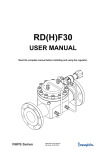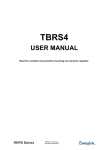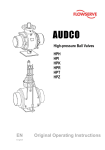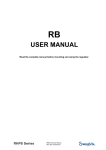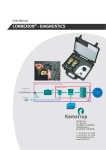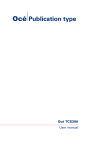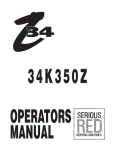Download CRS4, 6 - Swagelok
Transcript
CRS4, 6 all types of connections USER MANUAL Read the complete manual before installing and using the regulator. CRS4,6 User Manual Rev.date: 20-09-2010 WARNING INCORRECT OR IMPROPER USE OF THIS PRODUCT CAN CAUSE SERIOUS PERSONAL INJURY AND PROPERTY DAMAGE. Due to the variety of operating conditions and applications for this product, the user is solely responsible for making the final proper decisions concerning the correct assembly and functioning of the product and assuring that all the performance, safety and warning requirements are met. • Users must be trained and equipped for the handling, use and servicing of pressure products and systems. • Users must contact their gas or liquid supplier for specific safety precautions and instructions. • Gaseous media should be free of excessive moisture to prevent icing at high flow. • Always wear the appropriate protective clothing, including safety glasses, gloves etc. if required. • Follow the applicable safety and maintenance procedures. • Obey specific local regulations. • Do not exceed the maximum inlet and outlet pressure of the product or its accessories. • Operate within the temperature limits and other conditions specified for the product. • Do not drop or damage the product in any other way. This may negatively effect the performance of the product which can cause the product to malfunction. • Venting fluids and gases can be dangerous. Vent to a safe environment away from people. Ensure adequate ventilation. • This product is not oxygen clean and therefore not suitable for oxygen service. If there are questions or problems regarding the installation, operation and maintenance these should be directed to the proper authority on site before continuing. CRS4,6 User Manual Rev.date: 20-09-2010 CONTENTS 1 Introduction .................................................................................................................................... 1 1.1 Detailed description ..................................................................................................................... 1 1.2 Special features and options ....................................................................................................... 1 1.3 Typical picture of a CRSN4 and its components ......................................................................... 2 2 Installation ...................................................................................................................................... 3 2.1 Points of attention before installation........................................................................................... 3 2.2 Installation instructions ................................................................................................................ 3 3 Operation ........................................................................................................................................ 4 3.1 Required tools for operation ........................................................................................................ 4 3.2 Points of attention before operation............................................................................................. 4 3.3 Changing the set pressure........................................................................................................... 4 4 Maintenance ................................................................................................................................... 5 4.1 Required tools for maintenance ................................................................................................... 5 4.2 Points of attention before removal from the system .................................................................... 6 4.3 Removal from the system ............................................................................................................ 6 4.4 Disassembly instructions ............................................................................................................. 6 4.5 Inspection of disassembled parts ................................................................................................ 6 4.6 Points of attention before assembly ............................................................................................ 6 4.7 Assembly instructions .................................................................................................................. 7 4.8 Recommended torques ............................................................................................................... 7 4.9 Testing ......................................................................................................................................... 7 5 Trouble shooting ............................................................................................................................ 9 6 PED Declaration ........................................................................ Fout! Bladwijzer niet gedefinieerd. CRS4,6 User Manual Rev.date: 20-09-2010 1 1 Introduction 1.1 Detailed description This regulator is a piston sensing pressure regulator, designed for high pressure gases and liquids. The regulator comprises a body and spring housing screwed together and has a removable seat and valve. The regulator is particular designed for use in dispensers for compressed natural gas, but other applications could be possible. The product is designed to be used between -20 °C and +80 °C, whether ambient temperature or media temperature. The regulator is soft seated for leak tight shut-off in zero flow conditions and is made of stainless steel. The design pressures for in- and outlet side are: • inlet 0 - 400 bar • outlet 0 - 400 bar Check the assembly drawing or regulator for the specific pressure limits of the supplied regulator. Standard features: piston sensing bubble tight shut-off 0-280 bar outlet pressure range Ø10 mm seat orifice balanced valve construction setscrew with nut to lock at the desired setpressure 1.2 Special features and options The regulator is available with the options: anti-tamper gauge port CRS4,6 User Manual Rev.date: 20-09-2010 2 1.3 Typical picture of a CRSN4 and its components 1 2 3 4 7 9 11 body springhousing (balance) o-ring ring bodyplug valve seat 12 13 14 15 16 18 19 springguide setspring valvespring pistonplate piston (bodyplug) o-ring (seat) o-ring CRS4,6 User Manual Rev.date: 20-09-2010 20 21 22 24 25 28 29 (body) o-ring bodyplate sliding bearing (piston) o-ring (piston) back-up ring nut setscrew (hexagon head) 3 2 Installation WARNING A PRESSURE REGULATOR IS NOT A SHUT-OFF VALVE AND SHOULD NOT BE USED AS SUCH. 2.1 Points of attention before installation This regulator can be equipped with different options and connections. Before installing the regulator you should fully understand the options and the suitability of your particular regulator and its suitability for the application. - It may be necessary to remove the regulator from the system during maintenance or service. Make sure that this is possible. The regulator is suitable for gases and liquids. Check if the materials on the assembly drawing, which came with the regulator, are compatible with the used media. Avoid sealing compounds which harden, be careful with anaerobic (loctite type) compounds. Particles of these compounds can run into the regulator and lock moving parts. Frequent assembly and disassembly of the in- and outlet fittings can damage the in- and outlet thread of the regulator. Damaged threads can cause serious injury. The product is designed to be used between -20 °C and +80 °C, whether ambient temperature or media temperature. In all other cases consult SWAGELOK B.V.. The regulator is standard not oxygen clean. The regulators are ultrasonically cleaned, but grease is used on the threads and o-rings. 2.2 Installation instructions - Verify that the regulator, the connections and its accessories are undamaged. Verify that the regulator and its accessories are suitable for the system operating pressure and have the proper connections. Carefully clean all pipes and connections. Any swarf, lint, wire etc. may cause seat leakage. Verify the flow direction of the system and mount the regulator accordingly. The standard connections of the CRSN4 are NPT threads, according to ANSI B1.20.1 Use teflon tape to get a proper sealing across the NPT threads. In case of BSPP parallel female, SWAGELOK B.V. recommends using bonded seal rings to get a proper sealing across the thread. Verify that the regulator is mounted in the system without stress on the connections. Stress on the connections can result in faulty connections and dangerous situations. Check if the in- and outlet fittings are fitted far enough into the regulator and check for leakage across the fitting. Shut-off valves should be mounted in the system for service or maintenance. If earthing is required, wind an earth wire around the springhousing and use a clamp to fix it. - CRS4,6 User Manual Rev.date: 20-09-2010 4 3 Operation 3.1 Required tools for operation To change the setpressure, a socket wrench 13mm is required. If the regulator is “factory set”, the setpressure is noted on the regulator. 3.2 Points of attention before operation - The product can be hot or cold, depending on the environment temperature and the used media temperature. Take the necessary precautions before operating or touching the product. If a shut-off valve at the outlet side is closed without changing the set pressure, the outlet pressure will rise a little. This phenomenon is usually referred to as the “lock-up” and does not indicate a problem with the regulator. A decrease in the flow will result in a rise of the outlet pressure. An increase in the flow will result in a fall of the outlet pressure and is usually referred to as the “droop”. This phenomenon does not indicate a problem with the regulator. A decrease of the inlet pressure will result in a rise of the outlet pressure. An increase of the inlet pressure will result in a fall of the outlet pressure. This phenomenon is usually referred to as the “dependency” and does not indicate a problem with the regulator. - - - 3.3 Changing the set pressure - Check the supply of medium at the inlet side. Make sure the inlet pressure is higher than the required outlet pressure and that the inlet pressure does not exceed the maximum allowed inlet pressure. Open the shut-off valve at the inlet side. Open the shut-off valve at the outlet side slightly to allow a minimal flow. Controlled outlet pressure settings are obtained by turning the setscrew. Turn the setscrew clockwise to increase, and counter clockwise to decrease the set pressure. A shut-off valve on the outlet side must be opened to relief the pressure on the outlet side. Open the shut-off valve at the outlet side fully to allow full flow during operation. Final adjustment must be made during operation to obtain the most accurate set point. - - CRS4,6 User Manual Rev.date: 20-09-2010 5 4 Maintenance WARNING INCORRECT OR IMPROPER REPAIR OR SERVICING OF THIS PRODUCT CAN CAUSE SERIOUS PERSONAL INJURY AND PROPERTY DAMAGE. SWAGELOK B.V. recommends the product to be removed from the system and to be shipped to SWAGELOK B.V. for service or maintenance as all products must pass rigid acceptance tests before leaving the factory. All repairs and servicing of this product must be performed by factory certified personnel and tested for operation and leakage. If this procedure is not followed for any reason, or if any customer changes are made to the product, SWAGELOK B.V. cannot assume responsibility for the performance or safety of a customer repaired product or for any damage resulting from failure of the product. The product should be checked periodically for proper and safe operation. It is the users sole responsibility to determine the frequency of maintenance based on the application. L RECOMMENDATION SWAGELOK B.V. RECOMMENDS TO HAVE SPARE-PART KITS READILY AVAILABLE ON SITE. All regulators require maintenance at scheduled intervals. Annual maintenance is recommended under normal use. From experience SWAGELOK B.V. can tell that especially during the start-up of a system, the demand for spare-part kits is high. This is despite all the effort taken to assure a clean system, there is usually some debris left in the system, which damages the regulator. Having spare-part kits on site will save time and money, as the downtime of the system will be reduced to a minimum, whether during start-up or normal operation. 4.1 Required tools for maintenance - a vice to fasten the regulator pincers to take out and place the o-rings a torque wrench socket to fit the torque wrench: 24mm (15/16” also fits) socket wrench 13 mm, to adjust the setscrew media and temperature compatible lubricant for reassembling threaded parts SWAGELOK B.V. uses Thurmo Past MA media and temperature compatible lubricant for o-rings SWAGELOK B.V. uses Molykote M55 soapy water for leak-testing - CRS4,6 User Manual Rev.date: 20-09-2010 6 4.2 Points of attention before removal from the system - SWAGELOK B.V. recommends removing the regulator from the installation. Make sure that a spare-part kit is present. Check if the used media is hazardous or toxic. If required take the necessary safety precautions to ensure a safe workspace and your personal safety. Vent to a safe environment away from people and ensure adequate ventilation. Follow your system safety, maintenance or special local procedures when removing the regulator. The product can be hot or cold, depending on the environment temperature and the used media temperature. Take the necessary precautions before operating or touching the product. - 4.3 Removal from the system - Isolate the regulator from all pressure sources by closing the appropriate valves in the system. Turn the setscrew counter clockwise to decrease the set pressure. Make sure that the inlet and outlet pressure are both reduced to zero. A shut-off valve on the outlet side must be opened to relief the pressure on the outlet side. 4.4 Disassembly instructions - Clamp the regulator in a vice. Remove the setscrew from the springhousing. Loosen the springhousing by turning it counter clockwise and put it aside. Take the setspring and spring guides out and put them aside. Take out the piston plate together with the piston and push the piston out of the pistonplate. Push the sliding bearing out of the pistonplate. Take the body out of the vice. Catch the bodyplate in your hand, while you turn the body upside down. Clamp the body in the vice, with the bodyplug facing upwards. Loosen the bodyplug by turning it counter clockwise and take it out of the body. Remove the valve, valvespring and valvering out of the bodyplug. Remove the seat and all the o-rings from the body, bodyplug and pistonplate. 4.5 Inspection of disassembled parts - Check the sealing edge of the seat and the sealing surface of the valve. Check the piston for abnormal wear. Check all other parts for abnormal wear. Replace parts in case of doubt. 4.6 Points of attention before assembly - All parts must be clean and undamaged before starting assembly. SWAGELOK B.V. recommends replacing all o-rings before assembly. All threaded parts must be lubricated a little before assembly, this to avoid galling of threads. All o-rings need to be lubricated a little to improve the lifetime of the o-ring and the performance of the regulator. CRS4,6 User Manual Rev.date: 20-09-2010 7 4.7 Assembly instructions - Clamp the body in the vice, with the bodyplug side upwards. Place the correct o-ring around the seat and place the seat in the body. Place the correct o-ring, the valvering, the valvespring and the valve into the bodyplug. Carefully place the bodyplug along with the correct o-ring in the body, do not damage the seat with the valvestem. Tighten the bodyplug with the recommended torque. - Take the assembled bottom out of the vice, turn it around and clamp it in the vice with the bodyplug facing downwards. Place the bodyplate into the body. Place the sliding bearing around the piston and push the sliding bearing into the pistonplate. You could use the vice to press it into the pistonplate. Check the mounted sliding bearing, by moving the piston. You should not feel friction when you move the piston. Place the back-up ring and then the piston o-ring into the pistonplate. Place the assembled pistonplate with the correct o-ring into the body. - - - Place the springguides and the setspring on top of the piston and keep them on place with one hand. Place the springhousing over the setspring and screw it into the body. Tighten the springhousing with the recommended torque. Screw the setscrew into the springhousing. 4.8 Recommended torques - Make sure that the regulator is completely pressure less, before you tighten the parts. - 4.9 - Bodyplug Springhousing 50 Nm 50 Nm Testing Check the regulator for leakage across the seat, with low- and high inlet pressure. Check the regulator for leakage across the piston, with low- and high outlet pressure. Check the required outlet pressure range. A well performing regulator is 100% bubble tight. If there is a leakage across the seat or the piston or leakage to the outside, the damaged parts must be replaced. CRS4,6 User Manual Rev.date: 20-09-2010 8 CRS4,6 User Manual Rev.date: 20-09-2010 9 5 Trouble shooting Problem: The outlet pressure creeps up, without turning the setscrew. Cause: A damaged valve and/or seat. Solution: Replace the valve and/or the seat. Problem: Leakage around the body plug. Cause: A damaged o-ring or insufficient torque on the body plug. Solution: Replace the o-ring ring or tighten the bodyplug according to the torque specifications. Problem: Leakage between the body and the spring housing or through the relief hole on top of the spring housing. Cause: A damaged piston o-ring or insufficient torque on the springhousing. Solution: Replace the piston o-ring or tighten the springhousing according to the torque specifications. Problem: The required outlet pressure can not be reached. Cause: The inlet pressure is not high enough. Solution: Make sure that the inlet pressure is sufficient. Problem: The outlet pressure rises too much when going from a dynamic to a static situation. Cause: There is too much flow in the dynamic situation. Solution: A larger regulator is required. Problem: The outlet pressure does not drop if the setscrew is turned counterclockwise. Cause: The regulator is non-venting. Solution: A shut-off valve in the outlet line must be opened to reduce the outlet pressure. Problem: The outlet pressure has changed without turning the setscrew. Cause: Changes to the inlet pressure will result in changes to the outlet pressure. Solution: Maintain a constant inlet pressure to the regulator. See section “operation” about dependency. Warranty Information Swagelok products are backed by The Swagelok Limited Lifetime Warranty. For a copy, visit swagelok.com or contact your authorized Swagelok representative. CRS4,6 User Manual Rev.date: 20-09-2010













